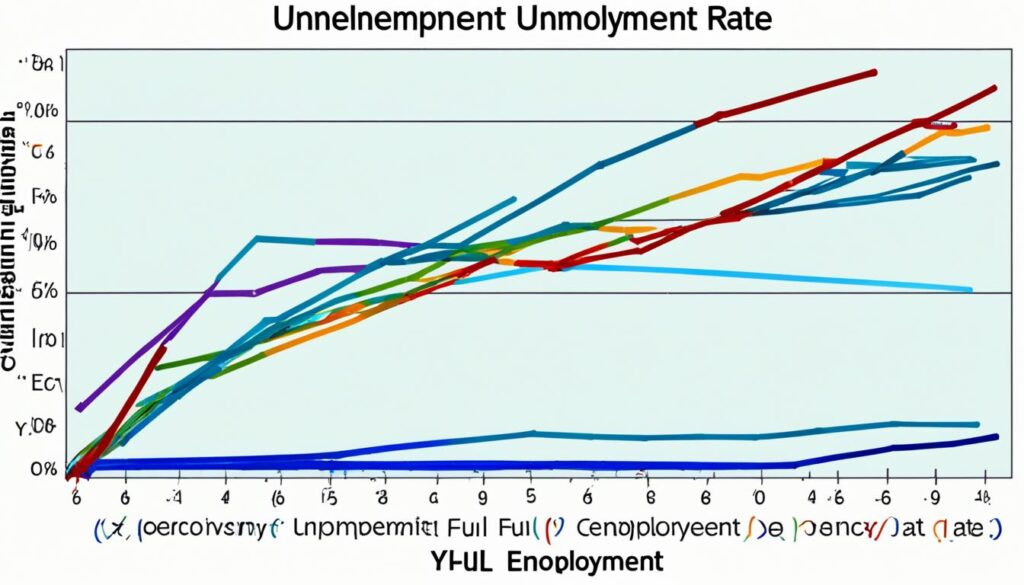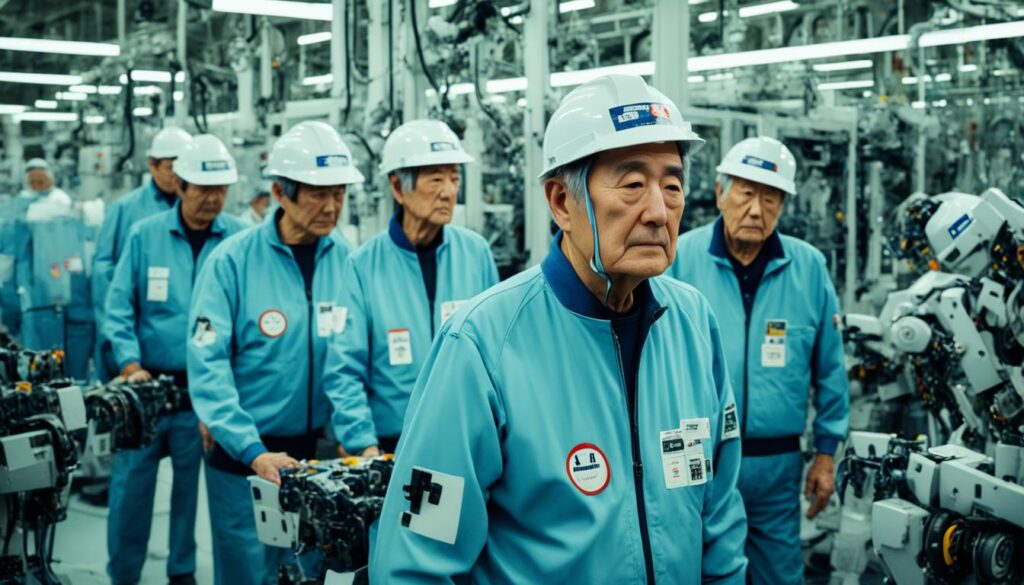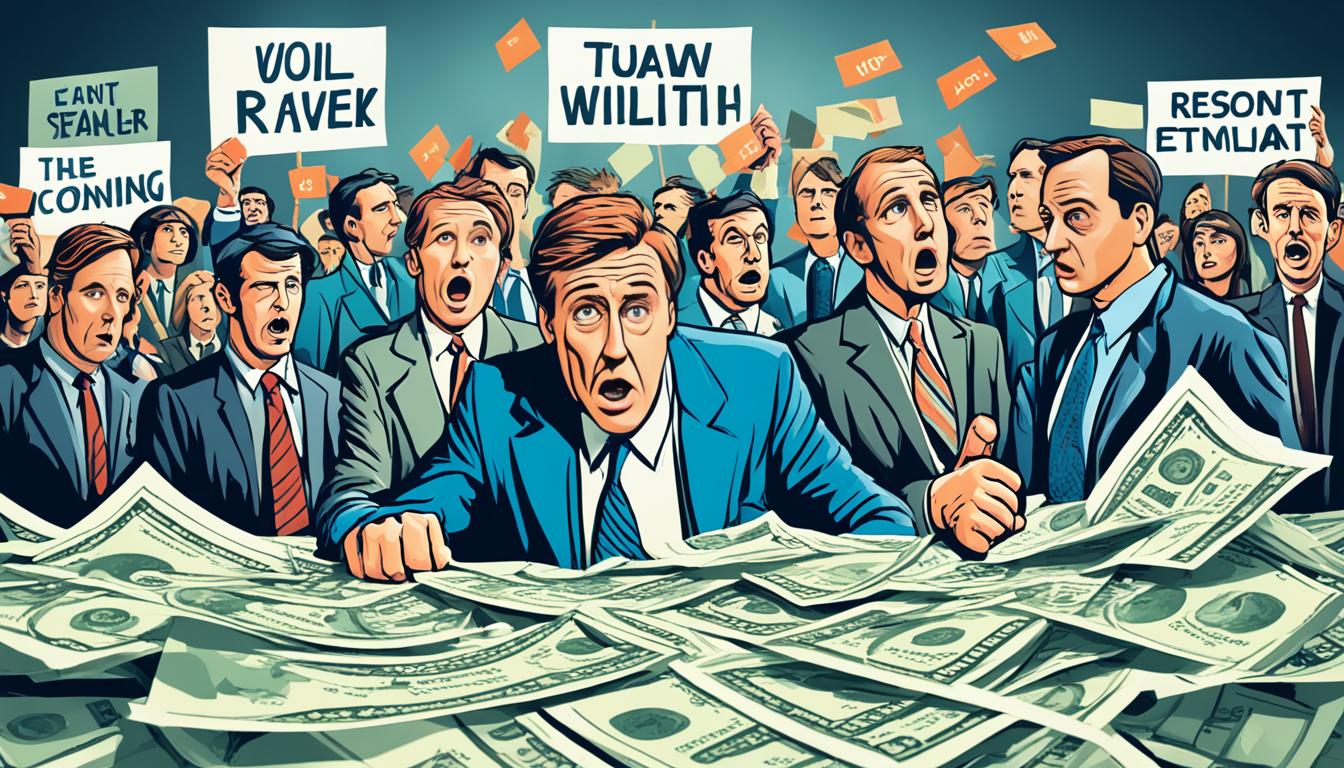“As an Amazon Associate I earn from qualifying purchases.”
Imagine a world where the economy is in a downturn, businesses are struggling, and the stock market is volatile, yet you and your loved ones maintain stable employment and steady incomes. This paradoxical scenario, known as a full employment recession, is an unprecedented economic phenomenon that defies conventional wisdom. As we navigate these uncharted waters, it’s crucial to understand the intricacies of this perplexing situation and its implications for our collective future.
Key Takeaways
- A full employment recession occurs when unemployment remains low despite a significant economic downturn.
- The U.S. economy is experiencing strong job growth and a low unemployment rate of 3.6%, even as the Federal Reserve raises interest rates to combat inflation.
- This phenomenon challenges traditional economic theories like Okun’s law and the Phillips curve, which link unemployment and economic growth.
- Experts attribute the resilient labor market to factors like labor shortages following the COVID-19 pandemic and structural unemployment.
- Navigating a full employment recession requires adapting to changing labor market dynamics and driving productivity growth.
What is a Recession?
A recession is typically defined as a significant economic contraction that persists for more than a few months, often characterized by two consecutive quarters of negative GDP decline.
Traditional Causes of Recessions
Previous recessions were triggered by events like the 2008 housing crisis, which led to widespread business closures and layoffs. The pandemic impact of COVID-19 in 2020 also caused a global economic downturn, leading to job losses and reduced economic activity.
Impact of the COVID-19 Pandemic
During the COVID-19 pandemic, the U.S. experienced high unemployment rates, followed by labor shortages and low unemployment rates as people returned to work. Despite this post-pandemic job growth, other economic indicators have continued to decline.
Measuring Economic Downturns
The nonprofit National Bureau of Economic Research (NBER) is responsible for officially declaring recessions in the United States based on various economic indicators, including GDP decline and economic contraction.
| Economic Indicator | Current Value |
|---|---|
| Federal Reserve Interest Rate | 5.25% – 5.5% |
| Inflation Rate (June 2023) | 3% |
| Monthly Job Growth (June 2023) | 209,000 jobs |
| Annual Wage Growth | 4.4% |
| Unemployment Rate (June 2023) | 3.6% |
| Full Employment Range | 4% – 6% |
According to economist Leonard Lardaro, if the capital sector slows for more than 5-7 months, a more traditional recession could ensue, despite the current post-pandemic job growth.
Understanding Full Employment
Full employment refers to an economic situation where all available labor utilization is maximized efficiently. It represents the highest level of employment an economy can sustain without causing inflationary pressures. Economists generally define full employment as an unemployment rate between 4-6%, allowing for some frictional and structural unemployment.
Definition of Full Employment
At its core, the full employment definition describes a state where nearly all able and willing individuals are engaged in productive labor. It doesn’t necessarily mean zero unemployment, as a certain level of joblessness is natural and healthy for a dynamic labor market.

Unemployment Rate and Full Employment
An unemployment rate of around 5% is often considered the benchmark for full employment in the real world. This rate accounts for frictional unemployment (temporary job transitions) and structural unemployment (skills mismatch). Economists view the natural rate of unemployment, also known as the NAIRU (non-accelerating inflation rate of unemployment), as the ideal balance between full employment and stable inflation.
| Country | Unemployment Rate (End of 2021) |
|---|---|
| Bahrain | 1.6% |
| Benin | 1.9% |
| Cuba | 3.6% |
| Germany | 3.2% |
| Japan | 2.6% |
| Malta | 3.5% |
| Mexico | 3.5% |
| Netherlands | 3.1% |
| Norway | 3.2% |
| Poland | 3.0% |
| Thailand | 1.3% |
The table above showcases countries that exhibited unemployment rates at or close to full employment levels at the end of 2021. In January 2023, the United States experienced a 3.4% unemployment rate, historically considered a very low rate approaching full employment.
Full Employment Recession
A full employment recession is an unprecedented economic condition where the labor market remains resilient with low unemployment and job growth, even as the capital sector experiences a decline typical of a recession. This unparalleled phenomenon contrasts with traditional economic models, as the United States has never encountered such a situation before.
Characteristics of a Full Employment Recession
In a full employment recession, businesses and the stock market face recessionary pressures, characterized by slower growth and reduced profitability. However, the labor market defies expectations, with continued labor market growth and a tight job market. This divergence between the capital sector decline and the robust labor sector is a defining feature of this rare economic event.
Countries like Japan and Germany have experienced similar full employment recessions, driven by adverse demographic effects such as declining birth rates and an aging workforce. These demographic challenges have led to labor shortages, contributing to low unemployment rates despite economic contractions.
Unprecedented Nature of the Phenomenon
The full employment recession challenges traditional economic theories and models that link unemployment rates to economic growth. Typically, recessions are accompanied by job losses and higher unemployment, but this phenomenon bucks that trend. As definitions of recessions vary, the United States has not previously encountered a situation where the labor market remains strong amid a capital sector decline.
Recruiters and employers face unique challenges in a full employment recession, as the tight labor market makes it increasingly difficult to fill vacancies and attract talent. Effective recruitment and retention strategies become crucial in this unparalleled economic condition.
| Country | Key Demographic Trend | Labor Market Impact |
|---|---|---|
| Japan | Declining fertility rate (1.3 in recent years) | Shrinking workforce, full-employment recessions |
| Germany | Adverse demographic effects, aging population | Potential full-employment recessions |
| United States | Gen Z prioritizing job security, work-life balance | Tight labor market, recruitment challenges |
Causes of a Full Employment Recession
The current economic landscape in the United States is marked by a tight labor market, a lingering effect of the pandemic job shortage. As businesses reopened after the initial COVID-19 wave, they faced significant labor shortages, leading to a surge in post-pandemic job growth. This growth has persisted despite the Federal Reserve’s aggressive measures to curb inflation, including interest rate increases.
Labor Market Tightness
The tight labor market following the pandemic has been a driving force behind the full employment recession phenomenon. With businesses struggling to fill vacant positions, the demand for workers remains high, keeping unemployment rates remarkably low. This tightness in the labor market has been exacerbated by factors such as demographic shifts, skills mismatches, and changing workforce preferences.
Post-Pandemic Job Growth
As the economy emerged from the pandemic-induced downturn, businesses scrambled to rebuild their workforces, leading to a surge in post-pandemic job growth. This growth has been fueled by pent-up consumer demand, government stimulus measures, and the gradual reopening of various sectors. Despite the Federal Reserve’s efforts to cool the economy through interest rate increases, the labor market has remained resilient.

Federal Reserve Rate Hikes
To combat persistently high inflation, the Federal Reserve has been aggressively raising interest rates. Typically, such interest rate increases would lead to a slowdown in economic activity and job losses, as borrowing costs rise and consumer spending decreases. However, the labor market has defied expectations, with employers continuing to add jobs at a steady pace, even as the Fed implements inflation control measures.
| Economic Indicator | Value |
|---|---|
| Federal Reserve Key Interest Rate Range | 5.25% to 5.5% (highest in 22 years) |
| Inflation Rate (June 2023) | 3% (down from 9.1% a year earlier) |
| Jobs Added (June 2023) | 209,000 |
| Average Annual Wage Growth | 4.4% |
| Unemployment Rate (June 2023) | 3.6% |
Implications of a Full Employment Recession
A full employment recession presents a unique set of implications for both workers and businesses. In contrast to traditional recessions, the worker impact during a full employment recession is likely to be less severe. Most employees would not experience significant job losses or layoffs, allowing them to maintain job security and a steady paycheck.
Impact on Workers
One of the key advantages for workers during a full employment recession is the relative stability of the labor market. With unemployment rates remaining low, employees have greater bargaining power and may even be able to negotiate better compensation or benefits. However, it’s essential to note that job security might not be absolute, as some sectors or industries could still face challenges and potential downsizing.
Effect on Businesses and the Stock Market
While workers may experience minimal disruptions, businesses and the stock market are likely to bear the brunt of the recessionary impact. Companies may face slower business growth and reduced profitability, as consumer demand and spending patterns adjust to the economic downturn. This could lead to more cautious hiring practices, tighter budgets, and potentially even layoffs in certain industries.
Moreover, the stock market performance may suffer during a full employment recession. Investors may become more risk-averse, leading to increased market volatility and lower valuations for companies across various sectors. This could have implications for retirement portfolios, corporate investments, and overall economic confidence.
A full employment recession is a unique economic phenomenon where the capital sector experiences a downturn while the labor market remains relatively stable, presenting both challenges and opportunities for businesses and workers alike.
Theories and Models Explaining Full Employment
Several economic theories and models aim to explain the relationship between employment and economic growth, shedding light on the Okun’s law relationship and the Phillips curve tradeoff. These concepts provide insights into the dynamics of unemployment, economic output, and inflation, helping policymakers understand and navigate the complexities of a full employment recession.
Okun’s Law
Okun’s law, proposed by economist Arthur Okun, suggests that there is an inverse relationship between a country’s unemployment rate and its gross domestic product (GDP) growth. Specifically, it states that for every 1% increase in the unemployment rate above the natural rate of unemployment, a country’s GDP will fall by approximately 2%. This relationship implies that when GDP growth slows, unemployment rates tend to rise, and vice versa.
The Phillips Curve
The Phillips curve is an economic model that describes an inverse relationship between unemployment and inflation rates within an economy. It suggests that lower levels of unemployment tend to be associated with higher rates of inflation, and vice versa. This Phillips curve tradeoff has been a key consideration for policymakers and central banks in managing economic growth while maintaining price stability.
Natural Rate of Unemployment
The natural rate of unemployment, also known as the NAIRU (non-accelerating inflation rate of unemployment), represents the level of unemployment at which inflation remains stable. It is often considered the ideal balance between full employment and stable inflation, as it suggests that unemployment below this rate can lead to accelerating inflation, while unemployment above it can result in declining inflation.
| Country | Unemployment Rate (End of 2021) |
|---|---|
| Bahrain | 1.9% |
| Benin | 1.6% |
| Cuba | 2.8% |
| Germany | 3.5% |
| Japan | 2.8% |
| Malta | 3.5% |
| Mexico | 4.4% |
| Netherlands | 4.0% |
| Norway | 5.0% |
| Poland | 3.4% |
| Thailand | 1.4% |
The table above showcases the unemployment rates of various countries by the end of 2021, with many hovering around the natural unemployment rate of 5% or lower, which is often considered full employment in a real-world context. The United States, for instance, had an unemployment rate of 3.4% in January 2023, one of the lowest historical rates since 1948, when the lowest recorded rate was 2.7% in 1952. Under true full employment conditions, anyone who wanted to find a full-time job would be able to.
Historical Examples and Predictions
Japan has grappled with demographic challenges like a declining birth rate and aging workforce for decades, resulting in a shrinking labor pool. This demographic shift has led to periods where the country experienced low unemployment rates coupled with negative GDP growth, a phenomenon known as “full-employment recessions.” The combination of a dwindling workforce and stagnant productivity growth made it challenging for Japan to sustain economic expansion despite high levels of employment.

Germany, another advanced economy, is now being viewed as potentially experiencing a similar situation due to its own demographic challenges. With an aging workforce and slowing productivity growth, Germany may face increased risks of technical recessions in the future without significant productivity acceleration. Despite a strong economic outlook in recent years, the country’s demographic trends could pose long-term challenges in maintaining sustainable growth and full employment.
Japan’s Experience
Japan’s economic landscape has been shaped by its rapidly aging population and declining birth rates. As a result, the country has faced persistent labor shortages, with fewer workers available to drive economic growth. This demographic shift has led to periods where unemployment remained low even as the economy contracted, a phenomenon dubbed a “full-employment recession.”
Germany’s Potential Full Employment Recession
Germany, like Japan, is grappling with an aging workforce and unfavorable demographic trends. While the country has enjoyed a robust economic outlook in recent years, experts warn that without significant productivity growth, Germany may face an increased risk of experiencing technical recessions in the future, even with high levels of employment.
| Country | Demographic Challenges | Productivity Growth | Potential for Full Employment Recession |
|---|---|---|---|
| Japan | Declining birth rate, rapidly aging population | Stagnant | High |
| Germany | Aging workforce | Slowing | Moderate |
Challenges and Opportunities
The phenomenon of a full employment recession presents both challenges and opportunities for businesses and the overall economy. In this tight labor market, recruitment efforts face hurdles as labor shortages become more prevalent, making it increasingly difficult to fill vacancies. Employers must adapt and implement effective employee retention strategies to attract and retain top talent.
On the other hand, this situation also underscores the need for productivity improvement and emphasizes the role of innovation as a key economic growth driver. By enhancing productivity through technological advancements, process optimization, and workforce upskilling, businesses can mitigate the impact of demographic shifts and prevent prolonged full employment recessions.
Recruitment and Retention Strategies
In a tight labor market, recruiters must get creative to attract qualified candidates. Competitive compensation packages, flexible work arrangements, and robust employee development programs can set companies apart from their competitors. Additionally, fostering a positive company culture and focusing on employee well-being can bolster employee retention efforts.
Productivity and Economic Growth
Improving productivity is crucial for sustaining economic growth in the face of demographic challenges. Investments in research and development, automation, and workforce training can drive innovation and boost output per worker. Collaboration between businesses, policymakers, and educational institutions can also promote economic growth drivers such as entrepreneurship, technological adoption, and skill development.
| Country | Fertility Rate | Population Trend |
|---|---|---|
| Japan | 1.3 | Decreasing since late 2000s |
| Germany | 1.54 | Potential full-employment recession |
As illustrated by the table, countries like Japan and Germany are grappling with declining fertility rates and aging populations, which can contribute to labor market tightness and potential full employment recessions. Addressing these demographic challenges through productivity improvement and economic growth drivers will be crucial for long-term economic sustainability.
Conclusion
The full employment recession presents a significant economic challenge that necessitates careful consideration from policymakers and businesses alike. As this phenomenon unfolds, monitoring productivity levels and implementing strategies to drive future outlook economic growth will be crucial for navigating the changing landscape. While minimizing job losses for workers, the policy implications associated with demographic shifts and labor market dynamics cannot be overlooked.
Countries like Japan and Germany, which are potentially experiencing full employment recessions, serve as examples of how adapting to this unprecedented situation is essential for long-term economic stability. By fostering innovation, promoting workforce development, and encouraging strategic policy initiatives, nations can navigate the complexities of a full employment recession and position themselves for sustainable growth in the years to come.
As the global economy continues to evolve, embracing new paradigms and challenging traditional assumptions will be vital for maintaining competitiveness and ensuring prosperity for all. The full employment recession phenomenon underscores the importance of agility, forward-thinking, and a willingness to adapt to changing circumstances in order to thrive in an ever-changing economic landscape.
FAQ
What is a full employment recession?
What is the definition of a recession?
What is full employment?
What are the characteristics of a full employment recession?
What are some causes of a full employment recession?
How does a full employment recession impact workers and businesses?
What economic theories and models explain full employment?
What countries have experienced or may experience full employment recessions?
What challenges and opportunities does a full employment recession present?
“As an Amazon Associate I earn from qualifying purchases.”

